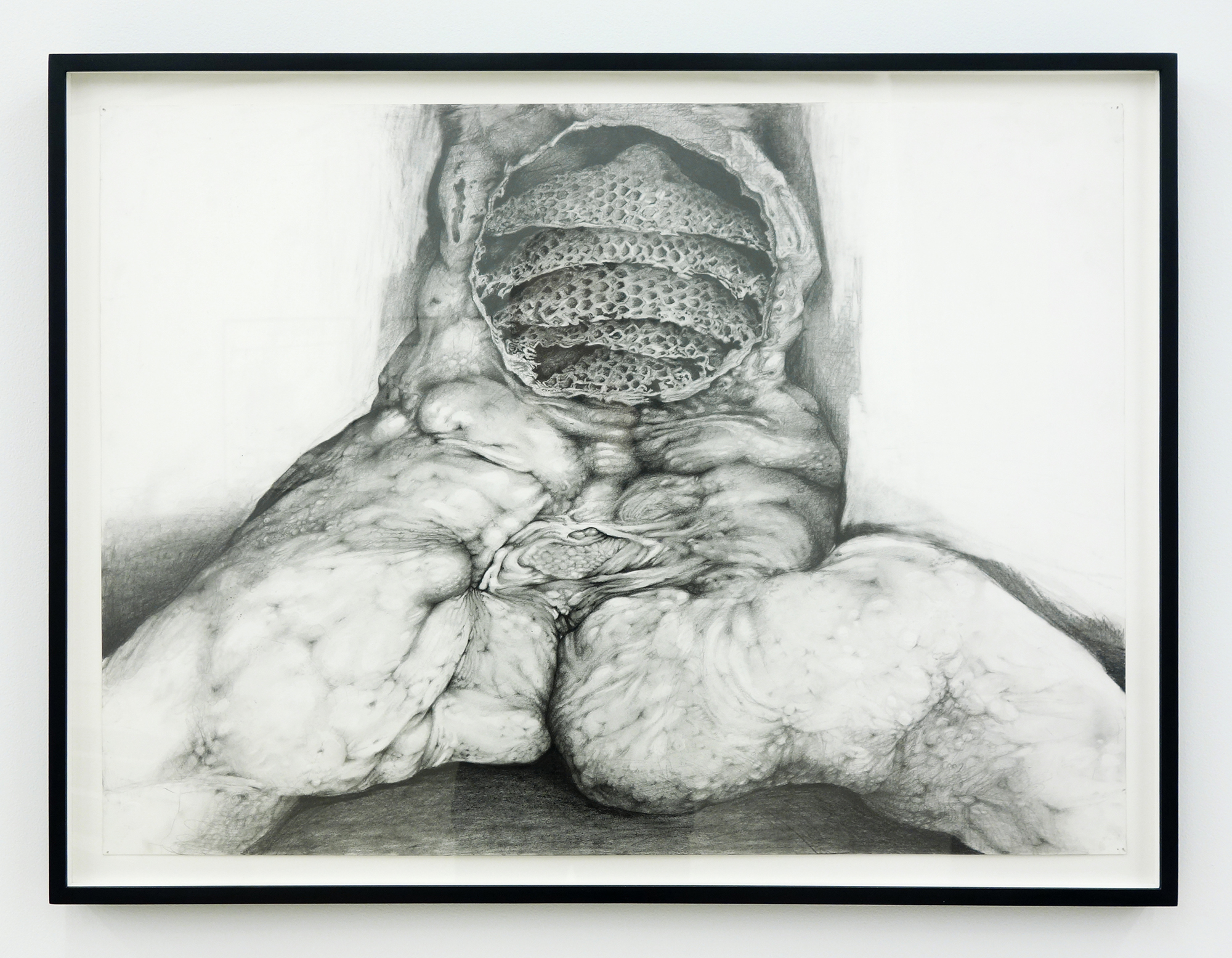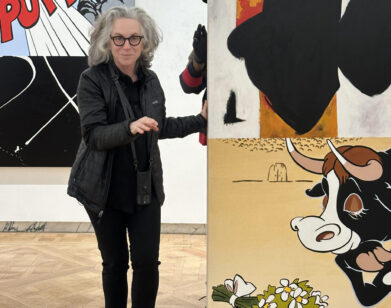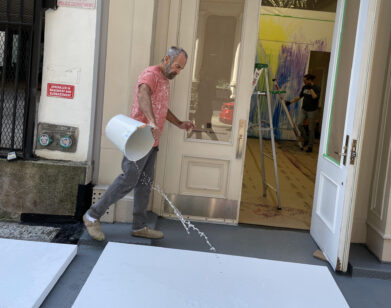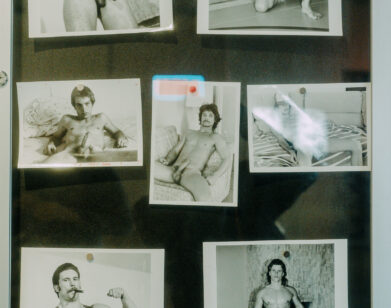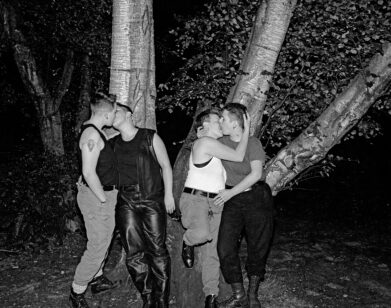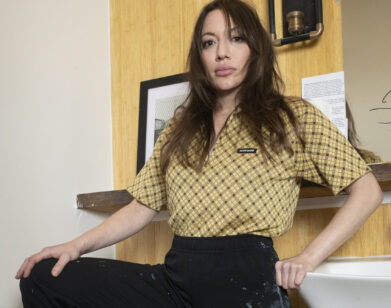Lionel Maunz Taps into Dark Corners of the Mind
It might be difficult to see how the work of an artist who often depicts dismembered and deformed body parts, particularly those of children and horses, could be refreshing. But the subtle emotional impact of Lionel Maunz’s art, mostly iron sculptures and pencil drawings, is one of a raw, profound pain expressed in such a delicate and measured manner so as to avoid staid aspirations of idealism or cynicism. It lingers elsewhere, stirring dark places in our minds that we are taught to suppress.
In his fourth solo show, “Fealty,” at New York’s Bureau gallery, Maunz explores the unsettling qualities he sees as inherent in motherhood and childrearing with three new large-scale sculptures and five drawings. Conceptually, the theme draws on the work of psychologists R.D. Laing, who in the 1970s was a vocal critic of what he saw as dismissive, removed attitudes towards mother and child during childbirth and early life, and Harry Harlow, infamous for cruel experiments designed to reveal consequences of social isolation on primates. Different elements that echo between works seem to evoke a narrative that, while certain details are extremely personal to Maunz, can trigger memories of family that resonate in broader societal contexts.
The main piece, Mother My Body Disgusts Me, comprises several concrete bases of different heights that serve as platforms for mutilated, faceless mother and father statues. The mother holds a headless infant, and its head is in a recess across from her. To her side are three niches containing iron figurines of a limbless torso misshapen with rope, a replica of Michaelangelo’s David emerging from a marble block, and another block that has been partially broken up into small cubes.
Maunz was raised in a rural Montana community around a number of horses, and as such, horses and related symbols make frequent appearances in his work. They were a dominant motif in his 2014 show at Bureau, titled “Deluge.” In “Fealty,” there is the iron Cleft, for which Maunz imagined a complex contraption that would be involved, in a destructive way, during the birth of a foal. In Double Bind, a child and horse are gruesomely melded together. Elsewhere, three graphite drawings, Obligation 1-3, portray early 20th century versions of incubators, which sealed babies off to prevent illness. The drawing Vertical Chamber recreates what essentially were solitary confinement cells for monkeys invented by Harlow. A disfigured female torso in the drawing New Mother plays off the “Mother” figure in Mother My Body Disgusts Me.
Though he earned his BFA and MFA in painting from Southern Methodist University, Maunz, 39, has been experimenting with sculpture since he moved to New York a decade ago. Cast iron eventually became his medium of choice, and his skill with the material, neglected by the many contemporary artists engaged in digital realms, has received attention: Aside from three previous shows at Bureau, Maunz’s sculptures were included in this year’s “Greater New York” group show at MoMA PS1, his section of which was extended to be on view through August. Meanwhile, he is preparing work for Statements at Art Basel in June, and has a show slated for 2017 at The Contemporary Austin.
As he has developed his aesthetic, Maunz has learned to temper a proclivity for violent, sometimes sexual, imagery with structured, architectural frameworks, a lack of color, and an almost classical sensibility. The effect is one that acknowledges hidden fears and shame without forcing us to confront them, leading us to a messy, disturbing, and truthful side of human nature.
We met with Maunz at Bureau, just before the opening of “Fealty.”
RACHEL SMALL: In general, your work seems to encompass unusual and manifold subject matter, at least, on the surface. In your view, how is this show different from your past shows?
LIONEL MAUNZ: It’s not a continuation, but, like in the last solo show [“Deluge,” in 2014], there are equestrian themes. That was starting already to carry over into the idea of child rearing and the brutality of that. It relates in a sense to, like with breaking and training horses, this whole process of learning. In the last show there were some childhood things, like children’s feet. That’s what kind of made sense to follow through on. And formation and education has always been an element of my work, and being attracted to the brutality of it, but also repulsed.
SMALL: To me, your figures, especially your sculptures, have a Baroque drama, but they somehow tap into a contemporary aesthetic.
MAUNZ: I definitely feel a bit out-of-step with a lot of contemporary work. I’ve always considered my work to be figurative and about bodies, but again, there are all sorts of stand-ins for bodies, like fragments, or implements that would be used on bodies.
SMALL: I feel like your aesthetic is very visceral. I don’t want to use the word “surreal” because that gets tossed around too much, but I feel like there is mystery, and it’s all very subtle. Like a psychological darkness. How did you develop your work to look this way?
MAUNZ: It’s always been there. The content has been pretty consistent. I don’t think it’s surreal. I’m really not trying to exaggerate anything. I’m trying to give it some essence of what it is to inhabit the body. So, in a sense, for me, I think my work is kind of realist.
SMALL: When you were younger, what made you want to pursue art? What did you want to explore within your aesthetic?
MAUNZ: When I finished high school, I was in a bad place and didn’t give a shit about anything. I’ve been drawing on and off for most of my life, so I was somewhat competent at it. So, it was like, “You know, fuck it. I’ll go to art school.” I did a little over a semester in Minneapolis at the College of Art and Design, [but] I had to drop out and went back to Montana and watched my life go nowhere doing dead end jobs for a couple of years. Then, a friend of mine was living in Dallas and going to school at SMU. His roommate moved out and he was like, “Hey, you want to move to Texas?” and I was like, “Fuck yeah.” I started just auditing classes and a couple of professors encouraged me to apply, and I did, and I got in. After those two years off, I was serious about it. My painting professor was this amazing painter named Bill Komodore. He was one of the first artists that I met and respected. And, yeah, I got into it pretty deep and haven’t looked back since. But, it hasn’t been calculated. It just happened.
SMALL: Amazing. Can you describe some of the previous themes for your solo shows at Bureau?
MAUNZ: I’m hesitant to give you a primary, thematic thing. But [the show “Deluge”] has absolutely nothing to do with animal rights. It has absolutely nothing to do with the industrial revolution and the move from animal to machine, or anything like that. In the past, people seem to have tried to apologize for the work by inserting their own thinking. But, you have this horse. Horses are incredibly powerful, grand things. They have all this historical baggage of royalty and violence and power. But then you also have this animal that’s broken and trained and submits completely to the will of the owner. There was something about the highness and the lowness of those two things. If I start with a narrow set of interests, they don’t remain there for long. The more time I spend with it, it becomes more complex and increasingly difficult to manage in a completely logical fashion.
SMALL: I feel like between the architectural elements in your work and the way you described the horses, there is almost this air of historical grandeur, in your works with horses, at least.
MAUNZ: It fits in with this idea of sovereignty, power, and control. I find myself in an uncomfortable place where, on one hand, I’m sort of allying with the abuses carried out by this grandiose power, and also in some way repulsed, which is where I want to be. That’s usually the spot where my work comes from: this untenability between my excitement and my repulsion.
SMALL: So, the main piece in this show is titled Mother My Body Disgusts Me.
MAUNZ: Yeah. The biggest figurative things I’ve done [including the figures in this work] are trying to get at some sort of fundamental spasm of the body and what it is to be a body and a consciousness…this sort of irreconcilable thing that beings are. Then there are, to a degree, personal references unique to my experience. [For example, in Mother My Body Disgusts Me], there is a reference to Montessori materials. [gestures towards a row of polished metal bars arranged in order from shortest to tallest]
SMALL: What is that?
MAUNZ: Montessori. It’s a type of education. These bars are for counting, they’re units of measurement. My mom was a Montessori teacher trainer and that’s how I was raised. My mom also had a statue of Michelangelo’s David, which she told me that she would meditate on when she was pregnant with me and try to perfect my form in utero and I always thought that that was really weird. I was also thinking about Michelangelo’s “Slave” sculptures. Nobody knows if they are complete or not. They’re phenomenal, but there’s much more of the original stone block that they were carved out of, and nobody knows whether it was intentional.
SMALL: What part of this did you conceive first?
MAUNZ: The mother was the first piece. The whole idea of this family group seems, on one level, so ludicrous and clichéd, which is what attracted me to it because it’s a difficult thing to deal with. Family is so impacting, but we’re so used to the accepted ways of processing familial relationships that it disappears in a way. I wanted to rip that apart. There are tropes that go through every family; they’re all violent and ugly and I don’t care how good your upbringing was, they still exist. I think it’s a matter of whether you are willfully blind to them or whether the good outweighs the bad, so you’re able to put that aside. R.D. Laing is a big touchstone. He said families and schools are like the slaughterhouses of children. But I think the big difference is that Laing is identifying this problem with the intent of putting forth some schema to prepare for the fucked-up-ness of the situation, [whereas] I am not at all interested in that. I am intentionally not positing any sense of betterment. I want it to cycle endlessly in this conflicted, confusing, desperate vortex. There’s no aspiration to my criticism, you know what I mean?
SMALL: I get that. The mother and the father figures have this strange, almost bubbling or blistering texture in certain places… How did you get that effect in the iron?
MAUNZ: It’s all originally sculpted in clay. I looked a lot at pictures of decay, which is a tough thing [to replicate] because it’s so much about viscosity and odor and fluid and color, which I don’t have access to in the iron. It’s a shorthand for these things of decay or these states of violence. I don’t want to get too carried away with anatomical representation. I want a rawness and a brute-ness to the approach. And I do have a tendency to obsess and over-articulate things. I try to find balance, where it doesn’t go too far in one direction or the other; it’s violated and brutalized, but not too obsessively.
SMALL: That makes sense. Also, you get a sense that they are human figures, but you end up trying to find the parts of them that aren’t clearly there.
MAUNZ: I would like to reduce the figure out of legibility into this degraded state…I mean, the body gets taken for granted in so many ways. I’d like to drop the bottom out of these fundamental issues with the body and problems with the body and looking at the body and thinking about the body, and make it much uglier and much less assumed.
SMALL: So, how does something like the drawing New Mother fit in?
MAUNZ: [Again,] it’s taking these things we take for granted—some inherent value of life, some inherent value that exists in breeding, some inherent value that exists in parenthood—and trying to eviscerate those things. I grew up in a religious cult and a strict community. The hornet’s nest [in the drawing] is in some way a reference to this sense of community that I find incredibly repulsive.
SMALL: Did the sculpture of the mother come first, or did this drawing come first?
MAUNZ: The drawing came after.. A lot of my drawings start from this book of electrical burns to genitals. It’s a medical book I have. Surprisingly, a lot of my drawings have begun there. I found it in a used bookstore in Texas when I lived there. For whatever reason, this idea of electricity, violence, and genitalia makes sense to me. So the original photograph is way different. Obviously it doesn’t have a wasp’s nest in it.
SMALL: The composition makes me think of a tree trunk…
MAUNZ: No… Obviously you’re welcome to see whatever you want, but if anything, I try and exaggerate things to make them more artificial. It’s necessary to separate the pictorial world we’re so used to seeing, televised and on the computer. We’re so accustomed to consuming it that we miss the intensity of the experience. So I am intentionally trying to make things artificial in the hope of getting back to that intensity. There’s a quote from Van Gogh which the painter Francis Bacon often repeated: “My great wish is to learn to change and remake reality. I want my paintings to be inaccurate and irregular, in such a way that they become lies, but lies that are more truthful than literal truth.” The gist of it is you need to lie and deform things into reality in the arts. Pictorial reality often misses all the terrible sensations and passions and fears and everything that constitutes our actual experience.
SMALL: Would you consider yourself an expressionist, like Bacon?
MAUNZ: No, not at all. I’ve never actually tried to quantify where I exist in that spectrum. I mean, I think pretty realistically. I don’t want gushing agony. I try to keep it focused however violent and cold…
SMALL: I feel like there is this organic element but it’s tempered with the iron and the brutality of the concrete. Then you’re snapped back to reality when you catch these very polished, measured Montessori metal bars in the center.
MAUNZ: It’s always been that dichotomy. I want the biological to feel threatened by these geometries and these clean, hard edges. Architecture that interests me has a fascistic [quality], like with prisons and things like that.
SMALL: What is the sculpture Cleft inspired by?
MAUNZ: It’s an equestrian reference. When horses are born they [naturally] have what’s called a deciduous hoof capsule, so their hooves don’t tear its mother’s uterus during birth. This is inverting that, creating something that would further wound the mother when the baby was born. So it’s a brutalized birth, imagining an inversion of it, where there’s this growth that more thoroughly damages the uterus.
SMALL: [laughs] Yeah, that would hurt. Are those oven-like objects in the Obligation drawings supposed to represent uteruses or wombs?
MAUNZ: No. These are getting into Harry Harlow, who was an important primate researcher. The whole animal rights movement was a response to the cruelty of his experiments. The history of parental and child relationships have evolved over the century. [Back when] they were figuring out that germs spread diseases through contact and kissing and such, [they used] what incubators for premature babies are now based on. The idea was to reduce their exposure to pathogens. It was weird, [the inventor] took them to circuses, and he’d have these displays of live children in these incubators. It was an obsessively well-intentioned move to reduce the fatality rates in foundling homes and hospitals. What Harry Harlow’s experiments deal with is the aspect of parent-child relationships [that says to] touch as little as possible. It became systematized, you know? Harlow’s big breakthrough was the importance of contact comfort, that babies need touch. Despite all the negativity thrown at him, it did change the environment of parental-child relationships.
SMALL: In the past, you’ve occasionally depicted faces and portraits in your sculptures. There are no faces in this show…
MAUNZ: There’s a baby face.
SMALL: Except for that. Was there any decision you made to mostly not show faces?
MAUNZ: The main piece is an attack on all families, but it’s also an extended attack on myself as a child, and my own issues with that. I am not trying to make it universal. For Art Basel, I am doing three portraits of important authors to me. When it’s right, it’s right, but when it’s not it can just be distracting, and ultimately I am less interested in the face and more interested in this sack of flesh that we all live in.
“LIONEL MAUNZ: FEALTY” WILL BE ON VIEW AT BUREAU GALLERY FROM APRIL 3 TO MAY 8, 2016.

